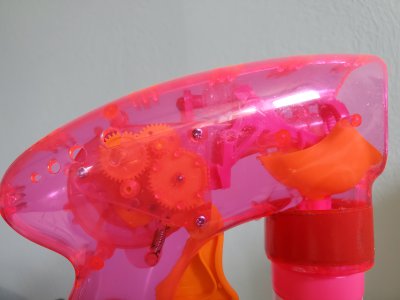POTD was doing some work on the starter of our Massey Ferguson 35 farm tractor. The starter has a ratcheting bendix that shoots out to engage the engine flywheel. It spins back into the "home" position once power is removed. Problem was, the bendix was stuck in the extended position so the starter was always engaged with the flywheel.
I now have another reason to love the internet. Google'd "starter bendix stuck out" and a 2 minute YouTube video from Steiner Tractors showed up. The bendix is held to the starter armature shaft with a roll pin. Tapped that out and spun the bendix back using a slight mod of Steiner's video. Their video has the bendix riding a screwdriver, then set the outside of the bendix to a spinning bench grinder with a wire wheel. Let it get up to smokin' hot speed, and push the base toward the gear. They use their hand on the base of the bendix, I used a steel round with a through hole.
I figured if the bendix over-traveled and stuck once, it'd do it again. Made a bushing on the lathe to act as a stop to limit travel of the bendix so it can't over-travel and get stuck again. I used brass which may not hold up, so may end up having to remake it in stainless or something similar. Yes, it reduces the amount of gear engagement to the flywheel. I measured the engagement at about 0.45", so hoping that'll be enough engagement.
Thanks for looking, Bruce
Bendix in the starter is stuck in the fully-extended position. Easy to hear when this happens and the tractor is running!
View attachment 322358
Bendix attaches to the starter armature shaft with a roll pin. The housing on the right with the pinion gear should rotate back on the helical gear to the base. Problem is, it's stuck fully extended.
View attachment 322359
Gotta love YouTube! Found a video from Steiner Tractors for fixing a stuck Bendix. Ran a screwdriver through the shaft that extends into the steel round on the right. Used a bench grinder with a Scotch-brite wheel and got the Bendix spinning. Then squeezed with the screwdriver and round to get the Bendix to fully retract.
View attachment 322360View attachment 322361
Bendix back on the armature. VERY carefully extended the pinion on the helix until the roll pin hole was just exposed.
View attachment 322362View attachment 322363
Made a stop-bushing/thrust washer to limit the travel of the Bendix. Basically measured the gap between the end of the pinion to the housing of the starter. Started to extend the pinion until it stuck. Figured a bushing 0.080" short of that number would work.
View attachment 322364
Simple lathe job from there. Chucked up some 3/4" brass (jury is still out on my choice of materials), faced, center drilled, drilled a clearance hole, bored both ID's and parted.
View attachment 322365View attachment 322366
View attachment 322367View attachment 322368
View attachment 322369View attachment 322370
View attachment 322371
Decided on the OD by measuring the distance across the bottom of the teeth on the starter pinion gear. Figured the flywheel teeth couldn't extend past there. Measured about 0.830", so went with a 0.75" OD bushing.
View attachment 322372
Dry fit the bushing in place and extended the Bendix. Didn't come out far enough to stick.
View attachment 322373View attachment 322374
Measured 2.030" from the face of the starter flange to the flywheel gear on the tractor. Measured 1.900" on the starter, so in the retracted position there's about an 1/8" clearance between the Bendix and the flywheel gear. The Bendix gets about 0.60" of travel with the bushing in place, so getting about 7/16" of gear tooth engagement.
View attachment 322375View attachment 322376
Success! Works great though I'll pull the starter after the summer and see how the brass is holding up.
View attachment 322377























